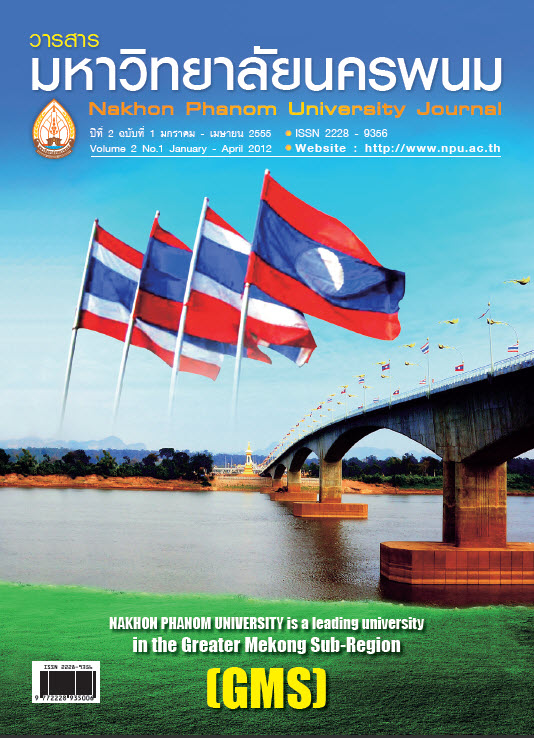การเปรียบเทียบผลการจัดกิจกรรมการเรียนรู้ เรื่อง เคมีอินทรีย์ กลุ่มสาระการเรียนรู้วิทยาศาสตร์ชั้นมัธยมศึกษาปีที่ 6 ที่ได้รับการสอนแบบ 4 MAT กับที่ได้รับการสอนแบบปกติ
Main Article Content
Abstract
การวิจัยนี้มีวัตถุประสงค์เพื่อศึกษาและเปรียบเทียบผลสัมฤทธิ์ทางการเรียน เรื่อง เคมีอินทรีย์ กลุ่มสาระการเรียนรู้วิทยาศาสตร์ความสามารถในการคิดวิเคราะห์ ความพึงพอใจต่อการสอนด้วยวิธีการสอนแบบ 4 MAT กับการสอนแบบปกติ กลุ่มตัวอย่างเป็น นักเรียนชั้นมัธยมศึกษาปีที่ 6 โรงเรียนโนนกอกวิทยา จำนวน 74 คน โดยการสุ่มแบบกลุ่ม เครื่องมือที่ใช้ในการวิจัยมี 3 ชนิด ได้แก่ แผนการสอนแบบปกติ แผนการสอนแบบ 4 MAT แบบทดสอบชนิดเลือกตอบ 4 ตัวเลือก ได้แก่ แบบทดสอบวัดผลสัมฤทธิ์ทางการเรียนวิชาเคมี จำนวน 40 ข้อ ซึ่งมีค่าอำนาจจำแนกรายข้อ ตั้งแต่ 0.22 ถึง 0.77 ค่าความเชื่อมั่นทั้งฉบับเท่ากับ 0.94 แบบทดสอบวัดความสามารถในการคิดวิเคราะห์ จำนวน 30 ข้อ มีค่าความยากตั้งแต่ 0.32 ถึง 0.75 ค่าอำนาจจำแนกรายข้อ ตั้งแต่ 0.21 ถึง 0.86 ค่าความเชื่อมั่นทั้งฉบับเท่ากับ 0.90 และแบบวัดความพึงพอใจต่อการเรียนเคมี จำนวน 20 ข้อ ซึ่งมีค่าอำนาจจำแนกรายข้อ ตั้งแต่ 1.76 ถึง 5.09 มีค่าความเชื่อมั่นทั้งฉบับเท่ากับ 0.90 สถิติที่ใช้ในการวิเคราะห์ข้อมูล ได้แก่ ร้อยละ ค่าเฉลี่ย ส่วนเบี่ยงเบนมาตรฐาน และ F-test (One-way MANOVA) ผลการวิจัยพบว่านักเรียนที่ได้รับการสอนแบบ 4 MAT มีผลสัมฤทธิ์ทางการเรียนวิชาเคมี เรื่อง เคมีอินทรีย์ ความสามารถในการคิดวิเคราะห์ และความพึงพอใจ มีค่าเฉลี่ยของคะแนนสูงกว่าการสอนแบบปกติอย่างมีนัยสำคัญทาง สถิติที่ระดับ .01
The purposes of this research were to study and compare learning achievement in science learning group on the issue of organic chemistry, analytical thinking, and students’ satisfaction between using the 4 MAT teaching approach and the conventional teaching approach. The sample groups were 74 grade twelve students at Nonkokwitthaya School. They were selected through the Cluster Random Sampling technique. The research instruments used in this study were three types: the lesson plans of traditional teaching approach, the lesson plans of the 4 MAT teaching approach, and the multiple-choice test which was a 40-item chemistry learning achievement test with discrimination value at 0.22-0.77 and a reliability of 0.94, the 30-item analytical thinking test with difficulty ranging between 0.32-0.75, a discrimination value at 0.21-0.86 and a reliability of 0.90, and the 20-item satisfaction questionnaire on the chemistry learning with a discrimination value at 1.76-5.09 and a reliability of 0.90. The statistics employed in the study were percentage, mean, standard deviation and F-test (One - way MANOVA). The results of the study revealed that the students who have been taught the 4 MAT learning approach showed more competence of learning achievement, analytical thinking, and satisfaction with chemistry learning than those who have been taught the traditional learning approach at the significance level of .01


